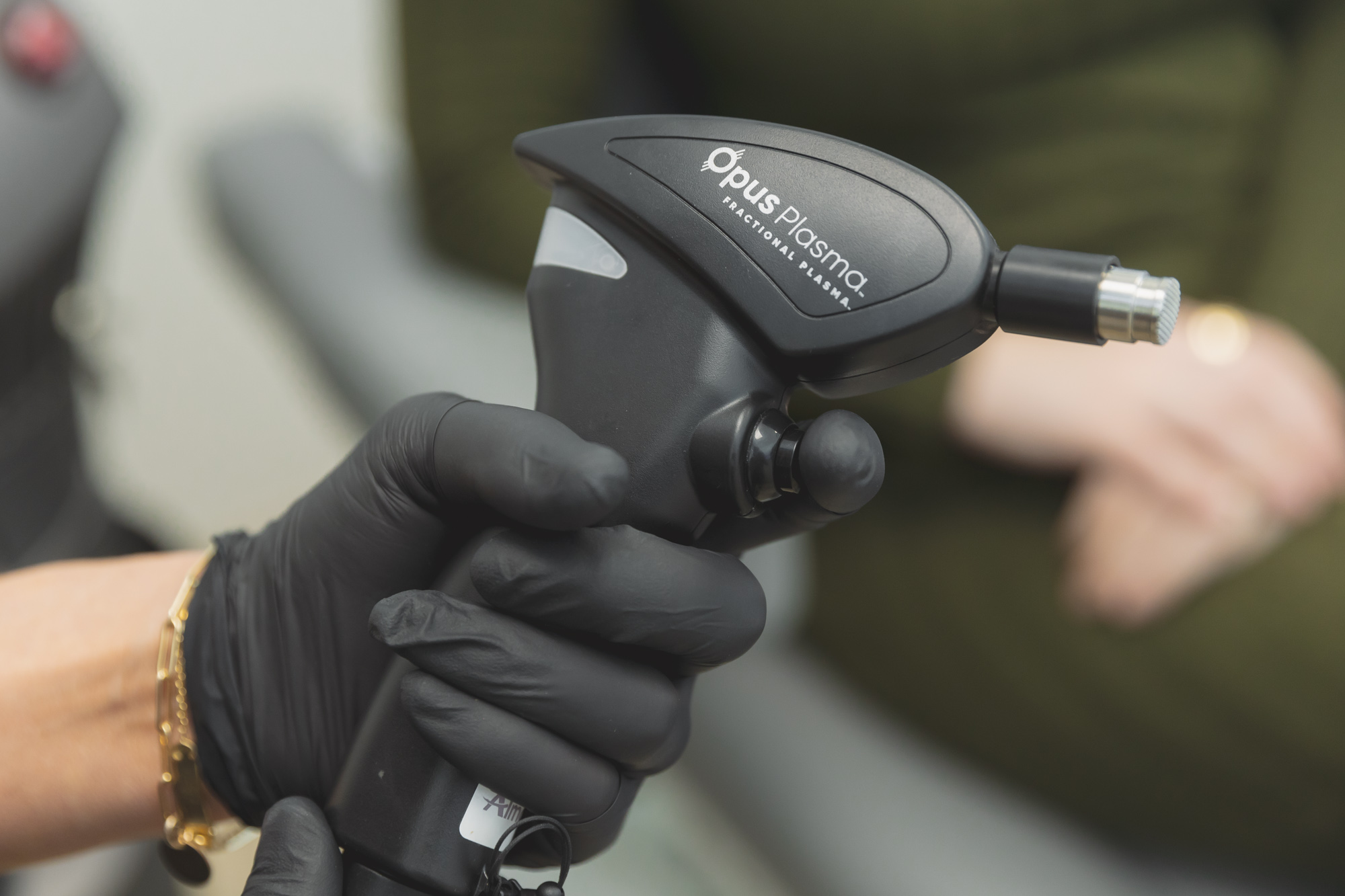Introduction
Looking for a way to turn back the clock without disrupting your busy routine? Opus Plasma might be your answer. This advanced skin resurfacing treatment, available at Serene Aesthetic Spa, combines two powerful modalities—plasma and radiofrequency (RF) energy—to rejuvenate your skin both on the surface and deeper within.
Here’s a quick snapshot of what Opus Plasma offers:
- Reduces fine lines and wrinkles
- Improves skin texture and elasticity
- Minimizes downtime compared to other treatments
In simple terms, Opus Plasma is a groundbreaking technology designed to refresh and renew your skin. It’s like hitting the reset button on aging skin by stimulating your natural collagen production without the extensive recovery time other treatments require.

What is Opus Plasma?
How Opus Plasma Works
Opus Plasma uses a unique combination of fractional plasma technology and radio-frequency (RF) energy to rejuvenate your skin. Imagine it as a high-tech pen that creates tiny microthermal zones on your skin. These zones, or “micro-injuries,” stimulate your body’s natural collagen production.
Here’s how it works in detail:
- Plasma Energy: The device emits unipolar RF energy, which reacts with the air to generate plasma. This plasma creates controlled micro-injuries on your skin’s surface.
- Fractional Technology: Unlike traditional lasers that treat the entire skin surface, Opus Plasma treats only a fraction at a time. This leaves surrounding tissues intact, speeding up the healing process.
- Collagen Production: The micro-injuries trigger your skin to produce more collagen and elastin, essential proteins for youthful, firm skin.
Benefits of Opus Plasma
Opus Plasma offers several advantages over traditional skin resurfacing treatments:
- Less Downtime: One of the standout benefits is significantly reduced downtime. Unlike fractional CO2 lasers, which can require weeks of recovery, most people experience only a few days of redness and swelling.
- Safety Profile: This treatment is safe for all skin types, including darker skin tones. Traditional lasers can sometimes cause hypo or hyperpigmentation, but Opus Plasma minimizes these risks.
- Versatile Treatment Areas: You can treat virtually any area of your body, including delicate spots like the eyelids and larger areas like the abdomen. Whether it’s fine lines on your face or stretch marks on your stomach, Opus Plasma can handle it.
The versatility and safety of Opus Plasma make it a go-to option for many skin concerns. Whether you’re looking to reduce fine lines, improve skin texture, or address acne scars, this innovative treatment has you covered.
Next, we’ll dive into the specific conditions Opus Plasma can treat.
Conditions Treated by Opus Plasma
Specific Areas Treated
Fine Lines and Wrinkles
Opus Plasma is highly effective in reducing fine lines and wrinkles. The plasma energy stimulates collagen production, which helps to smooth out these signs of aging. This treatment can be applied to areas like the face and neck, where fine lines and wrinkles are most common.
Skin Laxity
If you’re dealing with skin laxity, Opus Plasma can tighten and firm your skin. The treatment works by creating microthermal zones that promote skin tightening. Areas like the neck and decollete benefit significantly from this rejuvenation process.
Pigmentation
Unwanted pigmentation and uneven skin tone can also be treated with Opus Plasma. The technology targets and breaks down pigmented cells, helping to even out your complexion. This is especially useful for areas like the face and hands, which are often exposed to the sun.
Acne Scars
For those struggling with acne scars, Opus Plasma offers a non-invasive solution. The fractional plasma technology creates tiny injuries that trigger the skin’s natural healing process, reducing the appearance of scars over time. This treatment is effective on the face, where acne scars are most prevalent.
Stretch Marks
Stretch marks on the stomach and other parts of the body can be challenging to treat. Opus Plasma can help by promoting collagen and elastin production, which improves the texture and appearance of stretch marks.
Specific Areas Treated
Face
The face is a common area for Opus Plasma treatments. It addresses multiple concerns, from fine lines and wrinkles to acne scars and pigmentation. The treatment is quick, usually taking about 10 to 15 minutes.
Neck
The neck often shows signs of aging like wrinkles and skin laxity. Opus Plasma can tighten and rejuvenate this area, making it look more youthful.
Hands
Hands are frequently exposed to the elements, leading to pigmentation and skin laxity. Opus Plasma can treat these issues, making your hands look smoother and younger.
Decollete
The decollete area can develop wrinkles and pigmentation over time. Opus Plasma is effective in treating these signs of aging, providing a more even and youthful appearance.
Stomach
For those with stretch marks on their stomach, Opus Plasma offers a non-invasive solution. The treatment helps to reduce the appearance of stretch marks, improving the overall texture of the skin.
Opus Plasma is a versatile treatment that can address a wide range of skin concerns across various parts of the body. From fine lines to stretch marks, this innovative technology offers effective solutions for better skin.
Next, we’ll compare Opus Plasma with other popular skin treatments to help you make an informed decision.
Opus Plasma vs. Other Treatments
When it comes to skin rejuvenation, there are several options available. Let’s compare Opus Plasma with microneedling and fractional CO2 laser treatments.
Comparison with Microneedling
Microneedling involves creating tiny punctures in the skin using fine needles. These micro-punctures stimulate the body’s natural healing process, promoting collagen production.
Opus Plasma takes this a step further by using plasma energy to create microthermal zones. This not only stimulates collagen but also provides a more precise and controlled treatment.
Precision: Opus Plasma offers more control over the depth and intensity of the treatment compared to microneedling.
Rejuvenation Process: Both treatments stimulate collagen, but Opus Plasma can target deeper layers of the skin, offering more comprehensive rejuvenation.
Downtime: Microneedling generally has a shorter recovery time. However, Opus Plasma minimizes downtime compared to more aggressive treatments while still delivering impressive results.
Comparison with Fractional CO2 Laser
Fractional CO2 lasers have been a popular choice for skin resurfacing. They use laser beams to create micro-injuries in the skin, promoting collagen production.
Opus Plasma offers similar benefits but with less discomfort and downtime.
Patient Comfort: Opus Plasma is generally more comfortable. A numbing cream is applied before the treatment, and most patients report only mild pressure and heat sensations.
Downtime: Fractional CO2 lasers can require several days to a week of recovery. Opus Plasma cuts this downtime by about 50%, with most patients experiencing only a sunburn-like redness for 1-2 days.
Skin Types: Opus Plasma is safe for all skin types, unlike fractional CO2 lasers, which are not recommended for darker skin tones due to the risk of hyperpigmentation.
RF Microneedling: This treatment combines microneedling with radio-frequency energy for deeper skin rejuvenation. Opus Plasma also uses RF energy but in the form of plasma, offering a more versatile and customizable treatment.
In summary, Opus Plasma stands out for its precision, reduced downtime, and versatility in treating various skin types and concerns. Whether you’re considering microneedling or fractional CO2 lasers, Opus Plasma offers a compelling alternative with numerous benefits.
Next, we’ll discuss what you can expect during and after an Opus Plasma treatment.
What to Expect During and After Treatment
During the Treatment
When you arrive for your Opus Plasma treatment, the first step is to apply a numbing cream. This helps to make the procedure as comfortable as possible. The numbing cream is usually applied to the treatment area for about 15 to 20 minutes.
Once the numbing cream has taken effect, you’ll feel mild pressure and a heat sensation during the treatment. Most people tolerate this well. The actual treatment time is pretty quick—treating a large area like the face usually takes only 10 to 15 minutes. Smaller areas, such as the eyelids, can be treated in less than 10 minutes.
Post-Treatment Care
Immediately after your Opus Plasma treatment, you may notice some redness and a slight burning sensation, similar to a mild sunburn. This is normal and usually subsides within a few hours.
Most patients will have a sunburn-like appearance, which can last for a couple of days. You can go back to your usual activities immediately, but follow some aftercare instructions to ensure the best results and minimize any side effects.
Here are some key post-treatment care tips:
- Redness and Sunburn Look: Expect some redness and a sunburn-like appearance. This is normal and usually goes away within a few days.
- Mineral Makeup: You can apply mineral makeup after the first day to cover any redness.
- Aftercare Instructions: Your aesthetician will provide detailed aftercare instructions during your initial consultation. This usually includes keeping the treated area moisturized and avoiding direct sunlight.
- Avoid Scratching: It’s crucial to avoid scratching or picking at your skin to prevent any complications.
By following these guidelines, you can ensure a smooth recovery and enjoy the youthful, glowing skin that Opus Plasma aims to deliver.
Next, we’ll answer some frequently asked questions about Opus Plasma.
Frequently Asked Questions about Opus Plasma
How Many Treatments Will I Need?
Most people start to see improvements after their first Opus Plasma treatment. However, for the best results, you will likely need about 2-3 treatments spaced a month apart. These sessions help to stimulate collagen production over time, leading to more noticeable improvements.
How Long Do Results Last?
The results from Opus Plasma can last for several years, especially if you follow a good skincare routine. To maintain your youthful appearance, you might consider maintenance treatments every year or so. Combining Opus Plasma with other treatments like topical skincare products can also help prolong the results.
Are There Any Risks or Side Effects?
While Opus Plasma is generally safe, some people may experience mild side effects. These can include:
- Inflammation: Mild swelling is common and usually subsides within 48 hours.
- Redness: Your skin may look sunburned for a day or two.
- Tightness: Some people feel tightness in the treated area, which is a sign that the skin is healing.
- Dry Skin: You might notice some dryness, which can be managed with moisturizer.
- Flaking: Tiny scabs may form and flake off within a week. Avoid scratching to prevent complications.
By understanding these potential side effects and following your aesthetician’s aftercare instructions, you can enjoy the benefits of Opus Plasma with minimal discomfort.
Conclusion
At Serene Aesthetic Spa in Eastvale, CA, we are committed to offering comprehensive aesthetic services tailored to your unique needs. Our advanced skin care solutions, like Opus Plasma, provide effective and safe treatments to rejuvenate your skin and enhance your natural beauty.
Our dedicated team of skilled professionals ensures personalized care and attention throughout your treatment journey. We use state-of-the-art technology and scientifically-backed products to deliver results that exceed your expectations.
Whether you’re dealing with fine lines, wrinkles, acne scars, or skin laxity, our Opus Plasma treatment can help you achieve a smoother, more youthful complexion with minimal downtime. We invite you to experience the transformative power of advanced skin care solutions at Serene Aesthetic Spa.
Ready to discover the best version of yourself? Request an appointment with us today and let our experts guide you on your path to radiant skin.

